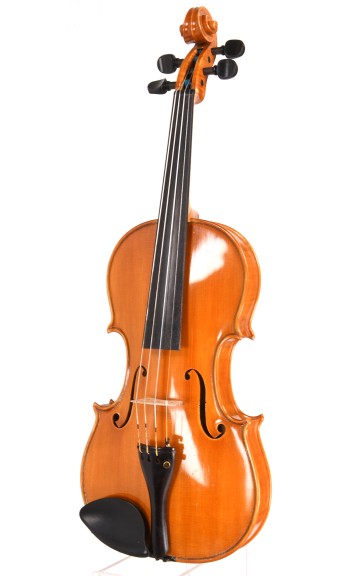Italian violins - the epitome of virtuoso craftsmanship
Italian violins enjoy an outstanding reputation in the music world and are widely regarded as the ultimate in virtuoso artisanry and excellent acoustic properties. And this truth does not solely apply to the Italian violins of the “golden age” of Cremona made by the most famous Italian violin makers Antonio Stradivari, Nicolò Amati, Lorenzo Storioni and Giuseppe Guarneri del Gesù who brought the modern Italian violin model to the heights which to this day serve as the internationally acknowledged and unsurpassed standard of artisanry. It is their accomplishments and the craft tradition of Italian violins and lutes dating far back to the late Middle Ages which allowed Cremona violin makers to achieve what they did, and over the centuries their traditions assumed the nature of a benchmark standard that served as a point of reference, even for the characteristic styles of violin making traditions in other countries.

Italian violins: a tradition of excellence
For example, Italy served as an indispensable source of both knowledge and inspiration as well as premium-quality materials for the work of such masters as Tyrolean Jakob Stainer, whose violins were more popular than the Italian violin classics up until the early 19th century. In the 20th century, a new circle of excellent contemporary violin makers in Cremona formed on the fringes of the violin making school in Cremona. The major role of Cremona and its historic venue should not detract from the virtues of other regional Italian violin making traditions that also featured perfectly crafted and distinctive Italian violins which are worthy heirs of Amati, Antonio Stradivari and Guarneri – and continually re-interpret the Italian violin anew. Explore a wide selection of exquisite Italian violins for sale, showcasing exceptional craftsmanship and magnificent sound quality, in Corilon's curated catalogue of Italian violins.
Fine Italian violins define excellence in string instruments
Italian violins are celebrated worldwide for their unmatched craftsmanship, tonal quality, and enduring legacy. Crafted in historic cities like Cremona, fine Italian violins embody centuries of tradition that began in the 16th century with Andrea Amati, who standardized the modern violin design. Over time, Italian violin makers like Antonio Stradivari and Giuseppe Guarneri del Gesù refined these designs, achieving a balance of acoustic brilliance and visual artistry.
Italian violin makers
The craftsmanship and techniques employed by Italian violin makers have had a profound influence on the art of violin making worldwide. Their innovations in design, wood selection, varnish, and construction techniques have shaped the standards and principles followed by contemporary violin makers.
The most important Italian violin makers of the golden age are Andrea Amati, Antonio Stradivari and Giuseppe Guarneri. Some famous families of Italian violins makers are the Amati dynasti and the Guarneri family in Cremona, and the Gagliano family of violin makers in Naples.
Some other important Italian violin makers
 Lorenzo Storioni (Cremona),
Lorenzo Storioni (Cremona), - Giovanni Battista Guadagnini (Turin),
- Michael Platner (Rome),
- Giovanni Francesco Pressenda (Turin),
- Nicolo Gagliano (Naples),
- Mario Gadda (Mantova) and
- Stefano Conia (Cremona).
From affordable contemporary Italian violins, old Italian violins, violins from Cremona, up to fine Italian violins with investment value: Corilon violins sales catalog introduces original Italian violins in a wide price range to order online. Browse our portfolio of authentic Italian violins presented with sound samples and discover their magnificent sound and outstanding craftsmanship. Find contemporary Italian violins, old Italian violins and fine Italian violins for sale at Corilon: with a 30 day returns option, a lifetime trade-guarantee that protects your investment, each one professionally set up and adjusted by our violin makers.
Authentic Italian violins: craftsmanship and value
Buying an Italian violin can be a significant financial commitment, but it can also be a rewarding one: Italian violins tend to gain value over time, making them not only a perfect violinist's choice but also a potential investment. As a renowned and one of the oldest Italian violin shop, Corilon offers an exquisite selection of handmade violins from Italy.
Violins by Italian violin makers are known for their exceptional sound quality and craftsmanship, making them true gems for discerning musicians. Whether you are a professional or an enthusiast, Corilon violins can provide perfect Italian violin that caters to your individual needs and preferences. With our own violin stores and workshops in Cremona and our years of experience and in-depth knowledge, we provide expert advice and support to ensure that you find the violin that meets your expectations. Purchase Italian violins which are ready to play with a 30 day return option, a trade-guarantee and a guarantee of authenticity.
Corilon's Italian violin collection - fine Italian violins for sale at affordable prices


























 Lorenzo Storioni
Lorenzo Storioni